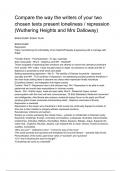Compare the way the writers of your two
chosen texts present loneliness / repression
(Wuthering Heights and Mrs Dalloway)
BRAIN DUMP/ ESSAY PLAN
BRAIN DUMP
Repression
Cathy1 proclaiming the indivisibility of her Heathcliff despite progressing with a marriage with
Edgar
Freudian theory - Psychoanalysis - Id, ego, superego
Stoic masculinity - Mrs D - Septimus and WH - Heathcliff
Those incapable of repressing their emotions are othered or receive the ultimate punishment
from society- WH- Cathy 1 does not gain peace in death, her presence on death and Mrs D -
Septimus is punished by shell shock and death
Setting representing repression - Mrs D - The sterility of Clarissa household - repressed
sexuality and WH - TCG symbolic of repression, not addressing societal problems therefore in
the more loose setting there is descent into chaos when repression finally resurfaces
Du”perfect hostess” and integration into higher society
Context - Mrs D - Repression due to the turbulent war, WH - Repression to be able to meet
patriarchal and social class expectations in victorian society
Genre - WH - Gothic tropes, meta and epic ideas, Mrs D - Modernist tropes, central
preoccupation with the inner self and consciousness, TS Eliot Wasteland, Modernist movement
and intelligentsia. Also Bronte also employs modernist tropes (focus on the past) and Woolf
employs gothic tropes (memories transcending death - Septimus memories of Evans)
Repression is rewarded
Repression is the reason why characters in both novels are continually trapped in pockets of
time due to their inability to properly address repressed emotions
Revolutionary criticisms and authors
Society as a whole repressing the chaotic times - symbolic or emblematic at Clarissa’s party
Keywords: Challenge, Evokes, Connotes (connotation), Juxtaposes, Illustrates, Demonstrates,
Undermines, Intimates, Reflects, Exemplifies, Refers, Exposes, Relates, Argue, Supports the
notion that…Explores, Reveals, Asserts, Can interpret this to mean, Shows, Inverts (inversion),
Justifies, Contradicts
“Who are you?”,” Catherine Linton”, “I’d lost my way on the moor”
“The world wavered and quivered and threatened to burst into flames” - semantic field of hell,
Personification of the world, past tense verbs of “wavered” and “quivered”
“It is I that is blocking the way he thought” -
“Everything had come to a standstill”
, “Everyone looked at the motorcar”- The motorcar symbolic of hierarchy, status but most
importantly conformity
“I will kill myself”- strongest symbol of Septimus attempting to break out of the socially isolated
prism of repression
“Heavy leaden circles dissolve into the air
Both Bronte and Woolf present repression as isolated social prisms that individuals in society
have no choice but to succumb to. This is significant because the backdrop of the societies
Woolf and Bronte were writing in repression was a social norm, seen as the quintessential
expression of stoic behaviour. In the Victorian era and modernist movement in which Bronte and
Woolf were writing, repression was paramount to the deemed successful social existence in
their respective societies. Therefore in the novels dialectic forms, they undermine the status quo
of socially accepted repression and challenge the repression in the chaotic socio-political
contexts of the Industrialisation era and cataclysmic event of WWI to critique the social prism of
repression and search for the self.
Both novels present repression as essential for survival in society, and without the ability for an
individual to repress they receive punishment. Bronte constructs the character Cathy 1 to be
symbolic of failed repression in Wuthering Heights. Cathy 1 in restrictive and repressive
Victorian society is unable to live a life without the taint of the “atmospheric tumult” acting as
engrained roots in her life. Bronte employs gothic tropes with a primary focus on meta and epic
ideas to illustrate how Cathy 1 transcends death to demonstrate how her punishment for failing
to conform to repression transgresses death. Bronte constructs Cathy even in death to lack
autonomy and control over her life. Her failure to repress her transgressive social desires
manifests itself in torment and torture in death. Bronte illustrates to the reader how Cathy1 is still
dependent upon societal structures and Victorian society to “let” her “in”, the poignant and
pathos-filled call of “let me in” demonstrates that since Cathy1 failed to completely comply with
the status quo of repression in Victorian society as she became a “lady” still proudly proclaiming
that “ I am Heathcliff”, she is ultimately damned for her failure to repress her past. The repetition
of “let me in let me in '' reinforces the idea of the unyielding, boundless, and everlasting
punishment for falling short of compliance with Victorian society's repression. Bronte constructs
the facade of conformity to repression as insufficient by Victorian societal standards of
repression. Therefore despite the facade of Cathy 1 conforming in society and repressing her
desires. Seen with Cathy 1 comes back from TCG a setting symbolic of social heaven as a “
lady” with “fine clothes and flattery”. Ultimately Bronte illustrates to the reader that Cathy 1’s
“fine clothes” are not originally for Cathy 1 but belong to someone else. Cathy 1 in her adulthood
temporarily adopted another person's repression, instead of truly repressing her own socially
transgressive desires. Therefore in death, Cathy appears as a weak “child” as she could not
succeed in adulthood repression, so is subjected to oppression in the extreme, oppressed in
death. Bronte demonstrates this punishment for failed repression so much so for Cathy 1 that
she is unable to get through the liminal space of the “window”, she can't cross the liminal space




